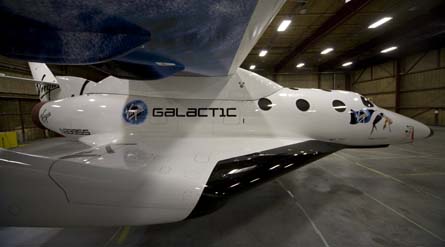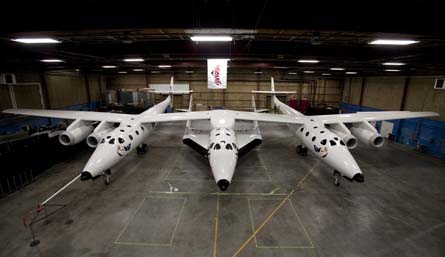Virgin Galactic's decade-long project to open the age of suborbital spaceflight for fare-paying passengers got a shot in the arm last month with a US Federal Aviation Administration green light for rocket-powered test flights of SpaceShipTwo.
With an FAA experimental launch permit in hand, Virgin hopes that by year-end it will see the first powered flights of SpaceShipTwo, which is carried to 50,000ft (15,250m) by its twin-fuselage carrier aircraft WhiteKnightTwo before release.
 |
|---|
Virgin Galactic Drop tests have verified SS2's capability to glide to a runway landing |
Drop tests conducted to date have verified SS2's capability to glide to a runway landing. But for flights into suborbital space, SS2 will engage its own rocket power after release to reach Mach 3.5 and climb beyond the atmosphere's official 100km (54nm) frontier to a maximum altitude of about 110km.
The six passengers and two pilots will experience about 6min of weightlessness - and stunning views - before re-entry and glide back to the 10,000ft runway at Spaceport America in the New Mexico desert, near the perhaps appropriately named town of Truth or Consequences.
A maiden voyage into space should closely follow the advent of powered flight testing, with the first paying passengers getting their taste of space some time in 2013, after earning a commercial permit for a suborbital reusable vehicle from the FAA.
According to Virgin Galatic chief executive George Whitesides, the plan is to run more drop tests this summer, to evaluate some new equipment and continue with the subsonic aerodynamics testing that began with SS2's first glide flight in October 2010.
The spacecraft itself is not yet ready for powered testing, although Whitesides says some components are being integrated by Scaled Composites, the Burt Rutan-run operation at Mojave that designed, and is building, a pair of SS2s and WK2s.
 |
|---|
Virgin Galactic Virgin Galctic has sold 500 tickets for its "astronaut" experience |
The rocket motor itself - called RocketMotorTwo, a hydroxyl-terminated polybutadiene and nitrous oxide-burning hybrid supplied by Sierra Nevada - is part of an integrated casing, nozzle and fuel assembly.
The second SS2 and WK2 currently under construction by Scaled will be largely identical to the first pair, which has been used in testing to date.
Getting this far has been a long trek. As early as July 2002, Virgin Group boss Richard Branson got involved with Microsoft co-founder Paul Allen, who was at that time embarking on his push to win the $10 million Ansari X-Prize, waiting to be claimed by the first privately designed, built and operated craft to reach space and return to Earth safely twice in short succession. Bankrolling a drop-launched Scaled Composites craft called SpaceShipOne, Allen went on to win the X-Prize in late 2004.
Then, at the 2005 AirVenture general aviation show in Oshkosh, Branson and Rutan announced the formation of the Spaceship Company, which would take SpaceShipOne as a starting point for developing what has become the much larger SS2.
The first WK2, named Eve, made its maiden flight in December 2008 and, after carry tests, first dropped SS2 for its glider return less than two years later.
Development of the Spaceport America facility has been more prominent recently than hardware development has. The state of New Mexico, sensing an opportunity to attract high-tech business on the back of Virgin's high-profile venture, has raised $210 million from a special tax levied to build the spaceport, and has even approved a 2,000ft extension to take the runway to 12,000ft. Virgin Galactic is so far the only company committed to operating from the spaceport, but companies including Armadillo Aerospace and Lockheed Martin have carried out testing there.
Whether the programme is running to schedule is not entirely clear, but the route to powered flight testing has not been all smooth. A 2007 rocket oxider coldflow test accident killed three Scaled workers, and least one runway incident which damaged Eve's landing gear raised some questions about aircraft control.
There is also the fundamental question of whether or not suborbital space tourism is going to be a sustainable business. In 2009, Rutan estimated it would be necessary to build 40 to 50 business jet-sized SS2s to meet demand that could run to several flights a day.
Whether Rutan proves to have been wildly over-optimistic is impossible to say at this early stage, but it is certainly true Virgin has had a great deal of success selling tickets. Last month it chalked up its 500th passenger, or astronaut as it calls them, in the form of Hollywood name Ashton Kutcher. That tally fills about 84 flights, and at $200,000 a ticket represents a cool $1 billion in revenue, including - as of end-2009 anyway - about $42 million in hand from paid-up tickets and $20,000 deposits.
Compared to the price of another Ferrari or beach house, $200,000 may be neither here nor there to the likes of Kutcher, but if it is to survive as a long-term business, Virgin Galactic is ultimately going to have to look below the ranks of multimillionaires for custom.
 |
|---|
And, Virgin Galactic is also looking beyond tourism. The company is developing a racking system that would allow SS2 to carry scientific payloads into weightlessness, technically micro-gravity, and has also investigated schemes to use the WK2-SS2 system to launch small satellites.
Another route to exploiting the hardware being developed could even be via NASA's ongoing push to bring privately developed launch systems into its Earth orbit astronaut transportation programme. Virgin has been linked to both Sierra Nevada, its SS2 engine supplier, and Orbital Sciences, which is also working on commercial crew transportation vehicles.
Not surprisingly, though, Virgin Galactic thinks big. As Whitesides puts it: "We have always felt that the most important thing Virgin Galactic could do is just to open space up dramatically to thousands and eventually, some day, millions of people.
"We are at about 515 people who have put down deposits for our service, and what's interesting about that is we're pretty close now to getting to the total number of people who have been to space, ever.
"The first thing I hope we could do over the next one to two decades is fly tens of thousands, hundreds of thousands, and one day millions of people into space. I think that will have an amazing effect on our planet."
Source: Flight International


























